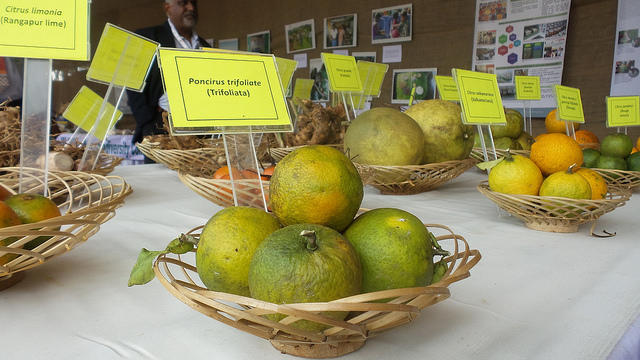Agricultural biodiversity for “The Future We Want” – a close-up on indigenous perspectives

Indigenous peoples from around the world gathered in Shillong, in north-east India, for the second Indigenous Terra Madre, where agricultural biodiversity was at the centre of discussion. Read the report by Bioversity International staff.
Indigenous peoples from around the world gathered in Shillong, in north-east India, for the second Indigenous Terra Madre, where agricultural biodiversity was at the centre of discussion. Read the report by Bioversity International staff.
By Gennifer Meldrum and Toby Hodgkin
When you look at a map of areas rich in agricultural biodiversity, it is striking that they largely coincide with areas inhabited by indigenous peoples. This connection and relationship between agricultural biodiversity and indigenous people pointed out by Phrang Roy (Coordinator of the Platform for Indigenous Peoples, Agrobiodiversity and Food Sovereignty), was a key inspiration for organizing the Second Indigenous Terra Madre. From 3-7 November, representatives from tribes around the world gathered to discuss issues of food sovereignty, biodiversity and indigenous peoples. The event, held in Shillong, Meghalaya in north-east India, featured a 3-day conference, a field visit to local communities and a public food fair with the participation of 600 delegates from 140 tribes and 58 countries.
The setting in north-east India was a perfect fit for the event, as the region is predominantly populated by indigenous peoples and hosts a spectacular level of crop diversity. The Platform for Agrobiodiversity Research and Bioversity International organized an exhibit with several partners to showcase this incredible crop diversity and approaches to conserve and secure its benefits. The exhibit focused on three crops that have a centre of diversity in the region: rice, taro and citrus. Thanks to the participation of the Indian National Bureau of Plant Genetic Resources, over 60 varieties of rice were on display, along with wild relatives of citrus, and a number of other locally important crops, such as Job's tears, tree tomato, perilla, maize, turmeric, ginger, and more.
A photo series in the exhibit also highlighted minor millets and the work that Bioversity International and the M.S. Swaminathan Research Foundation have carried out in Tamil Nadu, India, to promote these hardy and nutritious crops. The millet promotion initiative, supported by the International Fund for Agricultural Development, is continuing in a new phase in collaboration with Action for Social Advancement (ASA) in Madhya Pradesh. A delegation of indigenous farmers from this area participated in Terra Madre, and shared delicious millet-based treats (kutki kheer, kodo laddoo and ragi puri) at the food fair.
The importance of biodiversity for food and nutrition was at the centre of many discussions over the 3-day conference. The need to support indigenous peoples as conservers of this important resource was also highlighted throughout the event, acknowledging that there is still little understanding or rights for those who are the greatest stewards of the world’s agricultural biodiversity.
A lively discussion on building a global network for on-farm conservation took place in the plenary session on Agroecology and Agrobiodiversity in the Future We Want, following the suggestion by Bioversity International Senior Scientist Stefano Padulosi for the need of such a network. Several indigenous delegates highlighted the importance of securing land tenure for supporting their conservation role – if their land rights are protected, they will conserve biodiversity as they maintain their traditional livelihoods.
Food is an intrinsic part of cultural identity, especially for indigenous peoples. Several speakers emphasized this point, including Slow Food President Carlo Petrini, and asserted that food should not be seen and treated as a commodity. In a video address, His Royal Highness, the Prince of Wales expressed dismay, echoed by many participants, that most people no longer see themselves as being within nature, but standing apart from it.
Alternative indigenous visions for development were a major topic of discussion, where the role of community togetherness, cultural identity and happiness were raised as priorities for wellbeing. These aspects are often lost in development efforts focused purely on economic growth. Listening and giving a voice to indigenous peoples is essential to ensure fair development trajectories and could be key for solving many sustainability problems linked to modern practices. As Esther Wanjiku Mwangi (Porini Foundation) highlighted, quoting Einstein: “We cannot solve our problems with the same thinking we used when we created them.” Pat Mooney (ETC Group) described the nature of genuine participatory work, which should be initiated by the indigenous communities, from the original idea to defining the work plan.
It is difficult to capture the rich and varied nature of this extraordinary event in just a few words. However, one theme appeared over and over again throughout the discussions of these three days – the central role that agricultural biodiversity plays in building and maintaining the biocultural identity of indigenous peoples, addressing the challenges of climate change, strengthening wellbeing, improving health, meeting threats to pastoralism, and improving school feeding programmes.
The event contributed to moving toward “The Future We Want”, where it is envisioned that sustainable approaches like agroecology and local food systems are incorporated into public policies, marginalized voices are championed, food is honoured, and wellbeing and intrinsic values are recognized as important components of livelihoods. The Chief Minister of Meghalaya expressed his commitment to pursuing the idea of a recurrent Indigenous Terra Madre event in the State, as well as to establishing an agroecology centre in Shillong to share agroecological practices and promote the exchange of knowledge between scientists, indigenous peoples and local communities in the region, India and the world.
Photo: Citrus diversity. Material, courtesy of NBPGR, displayed at Indigenous Terra Madre in Shillong, India. Credit: Bioversity International/G. Meldrum
